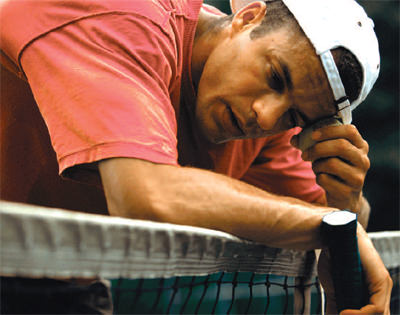August 1st, 2016
USTA Sport Science: Tennis Heat Illnesses, Tips to Succeed in the Heat
 Athletes increase their risk of heat illness as they become dehydrated. According to the National Athletic Trainers’ Association, it is not uncommon for athletes to reach significant dehydration and place themselves at risk of developing exertional heat illness in as little as an hour of exercise.
Athletes increase their risk of heat illness as they become dehydrated. According to the National Athletic Trainers’ Association, it is not uncommon for athletes to reach significant dehydration and place themselves at risk of developing exertional heat illness in as little as an hour of exercise.
This can be even sooner if the athlete comes into the practice or match already dehydrated.
A number of factors have been linked to heat cramps. Unlike other muscle cramps, such as those experienced with eccentric exercise, heat-related muscle cramps are usually a result of strenuous exercise in hot and humid conditions which results in a sweat and sodium loss. Muscle cramps can be largely avoided with adequate conditioning, acclimatization, rehydration, electrolyte replacement (specifically sodium) and appropriate dietary practices.
HEAT RELATED ILLNESSES
Heat Cramps
Causes: Excessive fluid loss; electrolyte imbalance; low-salt; poor acclimatization
Symptoms: Excessive sweating; cramping in abs or extremity
Treatments: Rest in cool place; passive stretching; water/electrolyte replacement; ice massage; stretch
Heat Exhaustion
Causes: Excessive fluid loss (sweating, diarrhea and vomiting); stimulant use; poor acclimatization; prolonged exercise in hot and/or humid conditions
Symptoms: Weakness, faintness, dizziness; headache; excessive thirst; vomiting; small urine volume or odor; skin is pale, cold, and clammy
Treatments: Rest in cool place, lying down; cold towel or sponge; water/electrolyte replacement; discontinue activity for 24 hours; Monitor weight
Heat Stroke
Causes: Same as for Heat Exhaustion, but cooling mechanisms of body are overwhelmed
Symptoms: Drowsy; hysteria; irritability; aggressiveness; disorientation; glassy stare; feel like “burning up”; rapid pulse and respirations; absence of sweat; skin is red, hot, dry
Treatment: CALL 911 — MEDICAL EMERGENCY!!! Immediate full body immersion in cold water; fan over body

1. Physically Prepare — The more physically fit the tennis player is, the less likely they will experience heat-related issues.
2. Drink, Drink, Drink — Drinking a combination of water and electrolyte-enhanced beverages throughout the day will help keep the tennis player well hydrated.
3. Don’t Rely on Thirst — Drink consistently, not just when thirsty. The body may be 2 percent dehydrated by the time thirst is experienced.
4. Increase Salt Content in Food and Drink — As salt is the major electrolyte lost in sweat, it is essential to replace this important electrolyte throughout the day. Foods that contain high salt content include vegetable juice, canned soups, sports drinks and salted pretzels.
5. Use Ice and Other Cooling Mechanisms — Keeping the body cool before, during and after practice or competition is helpful in maintaining an appropriate body temperature. However, putting ice directly on muscles and joints during play is not advised due to the possibility of muscle and joint stiffening.
6. Appropriate fuel before, during and after practice or match
7. Clothing — It is best to choose light-colored, breathable and loosely-woven fabrics to help sweat evaporate easily.
8. Sunscreen — In addition to helping reduce the instances of skin cancer, which is important for long-term health, applying liberal amounts of sunscreen will also prevent short-term sunburn that increases an athlete’s skin temperature and may make them more susceptible to heat-related problems.
9. Acclimation — It is important to get the body adapted to a hot environment. Most occurrences of heat illness take place in the first 2-3 days of training or competition in a hot and humid environment.
10. Reduce contact with direct sunlight when not playing
Acknowledgements:
This material was compiled by the USTA national body with the assistance of the following individuals:
Mark Kovacs, PhD, CSCS — Manager of Sport Science
Michael Yorio, MD — US Open Tournament Physician
Jessica Battaglia, MS, ATC/L — Assistant to Coaching Education and Sport Science
Paul Lubbers, PhD — Director of Coaching Education
Paul Roetert, PhD, FACSM — Managing Director of Player Development
Please see the USTA Player Development website for more information on heat and hydration issues at www.playerdevelopment.usta.com.


